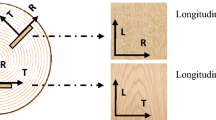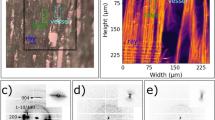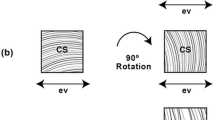Abstract
Spiral grain reduces the quality of timber since it causes twisting during drying and reduces the mechanical strength of wood products. The orientation of wood fibers in Norway spruce as a function of the distance from the pith was studied using both x-ray diffraction and light scattering. In radial-longitudinal plane upper tips of fibers were tilted towards the pith and the tilt angle increased gradually towards the bark in most of the samples. Periodic oscillations in the spiral grain angle were observed. Increased growth rate was found to increase the amplitude of this oscillation. There was no clear correlation between the angles determining the fiber orientation and other parameters like the lumen diameter, the cell wall thickness, the density of the sample, the fiber length, the circularity index of the cell lumen, or the mean microfibril angle. However, fiber orientation in tangential-longitudinal plane varied more in broad annual rings than in narrow annual rings.
Zusammenfassung
Drehwuchs verringert die Holzqualität, weil er zu Verdrehungen beim Trocknen führt und die mechanische Festigkeit der Holzprodukte verringert. Mittels Röntgenbeugung und Laserstreuung wurde die Faserneigung in Fichtenholz in Abhängigkeit vom Abstand zur Markröhre untersucht. In radial-longitudinaler Ebene neigten sich die oberen Faserenden zum Mark hin. Zur Rinde hin stieg der Neigungswinkel bei den meisten Proben allmählich an. Der Faserwinkel unterlag periodischen Schwankungen, die mit zunehmender Jahrringbreite grösser wurden. Eine eindeutige Korrelation zwischen den Faserwinkeln und anderen Parametern, wie zum Beispiel Zelllumendurchmesser, Zellwanddicke, Probendichte, Faserlänge, Rundheitsindex der Zelllumen oder dem mittleren Mikrofibrillenwinkel, konnte nicht festgestellt werden. Die Faserneigung in tangential-longitudinaler Ebene variierte jedoch bei breiten Jahrringen mehr als bei schmalen Jahrringen.
Similar content being viewed by others
References
Chalk L, Ortiz CM (1961) Variation in tracheids length within the ring in Pinus radiata D Don. Tappi J 45:628–634
Ekevad M (2004) Method to compute fiber directions in wood from computed tomography images. J Wood Sci 50:41–46
Eklund L, Säll H, Linder S (2003) Enhanced growth and ethylene increases spiral grain formation in Picea abies and Abies balsamea trees. Trees 17:81–86
Evans R, Stuart S-A, Van Der Touw J (1996) Microfibril angle scanning of increment cores by X-ray diffractometry. Appita J 49:411–414
Evans R (1999) Variance approach to the X-ray diffractometric estimation of microfibril angle in wood. Appita J 52:283–294
Gjerdrum P, Säll H, Storø HM (2002) Spiral grain in Norway spruce: constant change rate in grain angle in Scandinavian sawlogs. Forestry 75:163–170
Harris JM (1989) Spiral grain and wave phenomena in wood formation. Springer, Berlin Heidelberg New York
Hannrup B, Grabner M, Karlsson B, Müller U, Rosner S, Wilhelmsson L, Wimmer R (2004) Genetic parameters for spiral-grain angle in two 19-year-old clonal Norway spruce trials. Ann For Sci 59:551–556
Johansson M, Kliger R (2002) Influence of material characteristics on warp in Norway spruce studs. Wood Fiber Sci 34:325–336
Johansson M, Perstorper M, Kliger R, Johansson G (2001) Distortion of Norway spruce timber Part 2. Modelling twist. Holz Roh- Werkst 59:155–162
Kliger R (2001) Spiral grain on logs under bark reveals twist-prone raw material. Forest Prod J 51:67–73
Klug HP, Alexander LE (1974) X-ray Diffraction Procedures for Polycrystalline and Amorphous Materials. 2nd edn. Wiley-Interscience, New York
Kollman FFP, Côté WA (1984) Principles of wood science and technology, vol 1, Solid wood. Springer-Verlag, Berlin
Kozlowski TT, Huges JF, Leyton L (1967) Movement of injected dyes in gymnosperm stems in relation to tracheid alignment. Forestry 40:207–219
Kozlowski TT, Winget CH (1963) Patterns of wood movement in forest trees. Bot Gaz 124:301–311
Linder S (1995) Foliar analysis for detecting and correcting nutrient imbalances in Norway spruce. Ecol Bull 44:178–190
Lu W, Tan J (2004) Grain pattern characterization and classification of walnut by image processing. Wood Fiber Sci 36:311–318
Mäkinen H, Saranpää P, Linder S (2001) Effect of nutrient optimization on branch characteristics in Picea abies (L.) Karst. Scand J Forest Res 16:354–362
Mäkinen H, Saranpää P, Linder S (2002) Effect of growth rate on fibre characteristics in Norway spruce (Picea abies (L.) Karst.). Holzforschung 56:449–460
Mäkinen H, Saranpää P, Linder S (2002) Wood-density variation of Norway spruce in relation to nutrient optimization and fiber dimensions. Can J Forest Res 32:185–194
Northcott PL (1957) Is spiral grain the normal growth pattern? Forest Chron 33:333–352
Nyström J (2002) Automatic measurement of compression wood and spiral grain for the prediction of distortion in sawn wood products. Doctoral thesis, Division of wood Technology, Skellefteå Campus, Lulea University of Technology, Sweden, ISSN: 1402-1544ISRN:LTU-DT–02/37–SE
Nyström J (2003) Automatic measurement of fiber orientation in softwood by using the tracheids effect. Comput Electron Agr 41:91–99
Pape R (1999) Effect of thinning on wood properties of Norway spruce. Doctoral thesis, Swedish University of Agricultural Sciences, Uppsala, Silvestria 88
Peura M, Serimaa R, Sarén M-P, Saranpää P, Paakkari T (2005) The structure and cellulose deposition of Norway spruce tracheids grown in different nutritional conditions. Manuscript in preparation
Perstorper M, Johansson M, Kliger R, Johansson G (2001) Distortion of Norway spruce timber – Part 1. Variation of relevant wood properties. Holz Roh- Werkst 59:94–103
Sarén M-P, Serimaa R, Andersson S, Paakkari T, Saranpää P, Pesonen E (2001) Structural variation of tracheids in Norway spruce (Picea abies [L.] Karst.). J Struct Biol 136:101–109
Sarén M-P, Serimaa R, Andersson S, Saranpää P, Keckes J, Fratzl P (2004) Effect of growth rate on mean microfibril angle and cross-sectional shape of tracheids of Norway spruce.
Sepúlveda P, Kline DE, Oja J (2003) Prediction of fiber orientation in Norway spruce logs using an X-ray scanner: A Preliminary study. Wood Fiber Sci 35:421–428
Shen J, Zhou J, Vazquez O (2000) Experimental study of optical scattering and fiber orientation of softwood and hardwood with different surface finishes. Appl Spectrosc 54:1793–1804
Simonaho S-P, Palviainen J, Tolonen Y, Silvennoinen R (2004) Determination of wood grain direction from laser light scattering pattern. Opt Laser Eng 41:95–103
Sugiyama J, Okano T, Yamamoto H, Horii F (1990) Transformation of Valonia cellulose crystals by an alkaline hydrothermal threatment. Macromolecules 23:3196–3198
Wobst J, Olivervillanueva JV, Doebel R (1994) Variability of fiber angle in wood of ash (Fraxinus-Excelsior L.) and Douglas fir (Pseudotsuga-mensii (mirb) Franco). Holz Roh- Werkst 52:342–346
Zhou J, Shen J (2003) Ellipse detection and phase demodulation for wood grain orientation measurement based on the tracheid effect. Opt Laser Eng 39:73–89
Author information
Authors and Affiliations
Corresponding author
Rights and permissions
About this article
Cite this article
Sarén, MP., Serimaa, R. & Tolonen, Y. Determination of fiber orientation in Norway spruce using X-ray diffraction and laser scattering. Holz Roh Werkst 64, 183–188 (2006). https://doi.org/10.1007/s00107-005-0076-6
Published:
Issue Date:
DOI: https://doi.org/10.1007/s00107-005-0076-6




